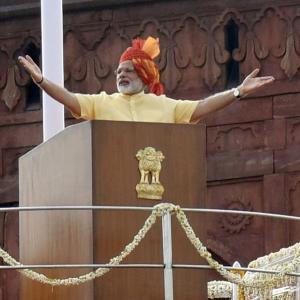The gap between Nifty's price-earnings multiple and economic growth is at a 12-year high

The lower-than-expected growth of the economy during the April-June quarter has widened the differential with equity valuations to an all-time high.
The benchmark Nifty50 index is trading at 24.2 times its trailing 12-months earnings per share, which is over four times economic growth in terms of gross value added (GVA) of 5.6 per cent during the first quarter of the current fiscal year (FY18).
This level has never been tested, not even during the bull market prior to the 2008 Lehman crisis.
The current valuation is nearly 60 per cent higher than the long-term median P/E to economic growth ratio of 2.7x.
This, analysts say, may trigger a de-rating of the equity valuations on Dalal Street unless there is a quick uptick in underlying economic growth.
“There is a close correlation between economic growth and corporate earnings.
The continued slowdown in the economy is likely to pull down corporate earnings, making it tough for bulls to maintain the current high valuations,” says Dhananjay Sinha, head of research, Emkay Global Financial Services.
Back-of-the-envelope calculations show that to achieve the historical average Nifty P/E to GVA ratio of 2.7x, India’s GVA growth needs to accelerate to 8.5 per cent, which looks difficult in an environment of poor corporate capital expenditure, low export growth, and deceleration in consumer expenditure.
The analysis is based on year-on-year growth in India’s quarterly GVA since April-June 2005 as provided by the Reserve Bank of India.
Gross domestic product is GVA plus indirect taxes net of subsidies. GVA growth has been compared to the trailing P/E multiple of the Nifty50 index during corresponding quarters.
Historically, a period of unsustainably high index P/E to GVA growth ratio has always been followed by a fall in stock prices and underlying valuations.
For example, the ratio had reached a high of 4.1x during the March 2013 quarter before the market correction in the following quarter.
Similarly, the ratio had reached a four-quarter high of 3.5x in the March 2015 quarter. In the next 12 months, the index capitulated almost a quarter of its value as corporate earnings failed to meet investors’ expectations.
The reverse has also been true. For example, the ratio reached a record high of 4.1x in March 2009 on the eve of the post Lehman recovery in economic growth and corporate earnings.
Similarly, a high ratio of 4.1x during the March 2014 quarter was followed by an uptick in economic growth aided by a decline in crude oil prices and introduction of the new GDP series.
Analysts expect an uptick in economic growth during the second half of 2017-18.
“We expect a turnaround in GDP growth during the second half as goods and services tax-related economic disruption tapers off and the economy receives a demand boost from higher government spending, However, the recovery is not likely to be strong enough to justify the current equity valuations,” says G Chokkalingam, founder and managing director, Equinomics Research & Advisory.
In other words, investors are showing extraordinary exuberance in the Indian markets even as the real economy is not growing fast enough for companies to generate an earnings momentum.
According to analysts, the current rally has been largely driven by a gush of liquidity on Dalal Street. This liquidity is on account of aggressive portfolio flows from both domestic and foreign institutions.
In the first eight months of 2017, foreign institutions have poured Rs 47,000 crore (Rs 470 billion) into Indian equities.
This has been supplemented by nearly Rs 69,000 crore worth of fresh buying by mutual funds, insurance companies and pension funds. This pushed benchmark indices to a new high in the absence of major selling.
“The current rally in the markets has been largely driven by liquidity. Investors are putting in more money anticipating better corporate earnings and dividend growth. However, the market valuations are now starting to look stretched in several segments and a further delay in earnings recovery could weigh down equities,” says Andrew Holland, chief executive officer, Avendus Capital.
The differential in the current earnings per share (EPS) and one-year forward earnings estimates shows how investors are banking heavily on an earnings recovery.
The trailing 12 months EPS of the Sensex lags its forward estimated EPS by more than 26 per cent, while the trailing 12 months EPS of the BSE MidCap index lags its forward estimates by close to 40 per cent.
Actual corporate earnings, however, have been stagnant for the last 10 quarters now.
The underlying EPS of the Nifty 50 index has been around Rs 395 since it hit a new high at the end of December 2014 quarter.
In other words, investors are now making money by selling stocks to each other at new highs and not because of growth in earnings and dividends. This cannot go on for too long.
Photograph: Arko Dutta/Reuters










